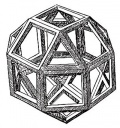Clothing
From The Art and Popular Culture Encyclopedia
|
"Look at that woman! Beneath her dress she's stark naked!" "I say, beware of all enterprises that require new clothes." --Walden (1854) by Henry David Thoreau "Ideas of modesty, therefore, are altogether relative and conventional. Peoples who are accustomed to tattoo themselves are ashamed to appear untattooed ; peoples whose women are in the habit of covering their faces consider such a covering indispensable for every respectable woman ; peoples who for one reason or another have come to conceal the navel, the knee, the bosom, or other parts, blush to reveal what is hidden. It is not the feeling of shame that has provoked the covering, but the covering that has provoked the feeling of shame."--The History of Human Marriage (1891) by Edvard Westermarck |

|
Related e |
|
Featured: |
Clothing protects the vulnerable nude human body from extremes of weather and other features of the environment. It is worn for safety, comfort, modesty (to hide intimate parts) and to reflect religious, cultural and social meaning.
Makeup
People also decorate their bodies with makeup or cosmetics, perfume, and other ornamentation; they also cut, dye, and arrange the hair of their heads, faces, and bodies (see hairstyle), and sometimes also mark their skin (by tattoos, scarifications, and piercings). All these decorations contribute to the overall effect and message of clothing, but do not constitute clothing per se.
Accessories
Articles carried rather than worn (such as purses, canes, and umbrellas) are normally counted as fashion accessories rather than as clothing. Jewelry and eyeglasses are usually counted as accessories as well, even though in common speech these items are described as being worn rather than carried.
The practical function of clothing is to protect the human body from dangers in the environment: weather (strong sunlight, extreme heat or cold, and precipitation, for example), insects, noxious chemicals, weapons, and contact with abrasive substances, and other hazards. Clothing can protect against many things that might injure the naked human body. In some cases clothing protects the environment from the clothing wearer as well (example: medical scrubs).
Humans have shown extreme inventiveness in devising clothing solutions to practical problems and the distinction between clothing and other protective equipment is not always clear-cut.
See also
- Clothing technology
- Textile design
- Naturism (which includes nudism)
- Second hand store
- Thermoregulation
- Timeline of non-sexual social nudity
- Timeline of requisite dress in Western civilization
- Bangladesh textile industry
- Bangladeshi RMG Sector
- Jaeger (clothing)

